What is death to the western sensibility but the ultimate assault on identity?
By Mark Fenton
Published November 30, 2017
Life, to be sure,
Is nothing much to lose,
But young men think it is,
And we were young.
-A. E. Housman
From 1995 to 1998, I was Hall Director at a Bates Residence, McMaster University. This meant living in the residence and making sure the residents didn't kill themselves. If this sound like hyperbole it isn't.
At the time, I was the only Hall Director there who had no other university affiliation (the jobs were intended for graduate students) and the circumstances that lead to my unlikely tenure are too tedious to narrate. Let's just say I was in the vicinity of the University and absorbed into its maelstrom, rather like the Pequod
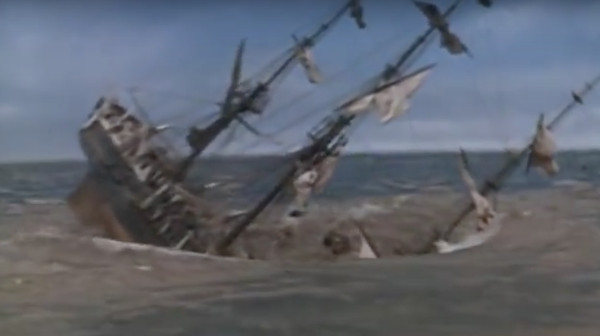
Moby Dick, directed by John Huston, 1956
and its attendant harpooning boats,
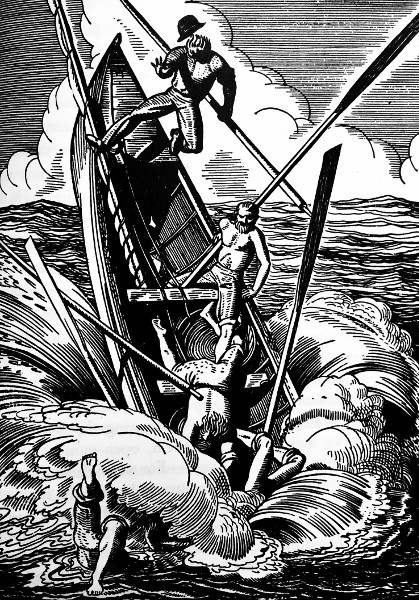
Moby Dick, illustrated by Rockwell Kent, 1930
are absorbed into the maelstrom of a plunging Moby Dick. (Is it just me or is it surprising that a man would don a bowler hat to go harpooning? Mr. Kent produced this stuff at the height of proletarian realism so I guess he researched it.)
My peers in the job had classes, taught, socialized, and I'm guessing had responsibilities off campus. I had no life outside the job since I was looking after two children under the age of four, and tended to my duties while pushing them around in a shopping cart stolen by the students.
This meant that except for trips out for groceries I was on campus 24/7/365.2421897 (and yes you do check the leap-year math as the kids are beating on one another with toys; you want to know the exact second they'll be old enough to leave home.) You've guessed my situation wasn't conducive to a balanced mental state.
To get what might be called closure on this part of my life, on a November Sunday in 2017 I revisited Bates. It was Fall Preview and parking was free.

I took the last available space. A student in McMaster colours materialized to ask if I needed directions. Ashamed of taking the last parking space when I was here not for Fall Preview, but on a frolic of my own, I contrived a spontaneous lie about meeting a daughter at Bates Residence for a tour. (My daughters are all but finished their post-secondary education at other schools; inexplicably those little monsters do become amazing adults.)
My lie meant the student-representative had to pour over a map designed for prospective students, which map she then gave to me. (You'll see Bates circled on it below and yes there is a lot of junk on my desk with which to procrastinate.)
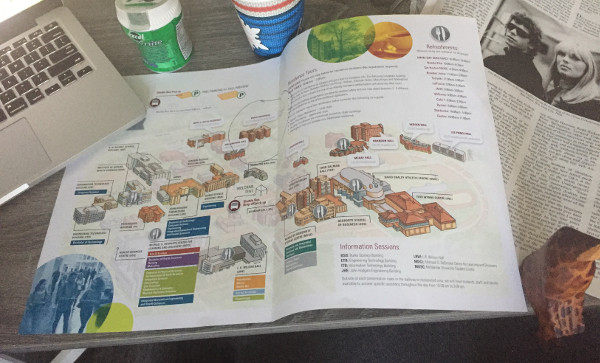
It took this dedicated greeter well over a minute to determine where Bates Residence was and come up with directions for me, directions I should have been giving her so she could better do her job. Obviously I, who used to be on campus 24/7/365.2421897, can find my way to Bates Residence blind from anywhere on campus, but now I had to languish for minutes in the pit of deceit I'd dug for myself.
After thanking her and proceeding on my way I glanced abjectly backwards

like Lot's wife or Orpheus or whatever, as she directed deserving parents to the halls of their children's future. Clearly McMaster campus is a nightmare from which I am still trying to awake.
I could probably argue that having been on call 24/7/365.2421897 for a job which, when actual work hours were calculated, paid about half of minimum wage, McMaster owes me half an hour of free parking even on a busy afternoon like this. But I still feel dirty.
* * *
Bates Residence: the building. I liked it then and I like it now. I think it's about the best international style architecture has to offer. Aesthetically I prefer it to the other buildings on campus, and certainly not because of the memories. Its proportions are beautiful. Design choices have to do with basic building materials and their colours. Brick does what brick should do. Glass what glass should do. And there's little superfluous decoration.

The exterior space of its entrance has an effortless relationship with the human body. It's like this mass of brick and concrete has a single vent through which it breathes us in and out.
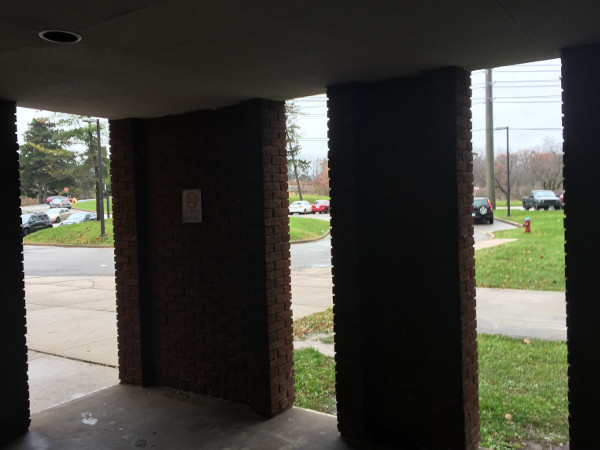
I'd forgotten about the memorial for a graduate student murdered in the residence two years before I started there.

I hesitated to refer to the incident in an essay this silly because it felt exploitive, but after considerable on-line research I thought it might be an opportunity to remember or become acquainted with someone who should still be in the world. You're on a computer. I encourage you to search her name and find remembrances by those who knew her, as well as the things done in her honour.
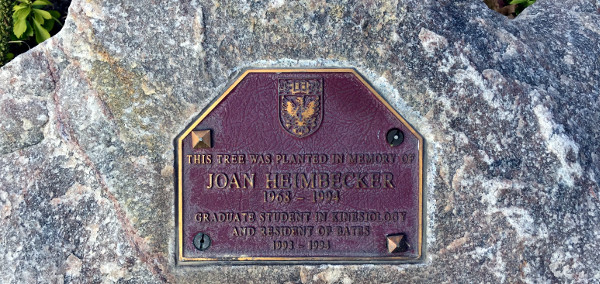
How the event affected me was that during my time at Bates the case came to trial. The Housing Office asked that I open her former room to the crown prosecutors so they could go over the crime scene. This meant informing the current residents that this was where it happened. They hadn't known.
* * *
Back at my desk, items ideal for procrastination include the several thousand photographs on my hard drive. Scrolling through them I found the image of a young woman in Day of the Dead makeup
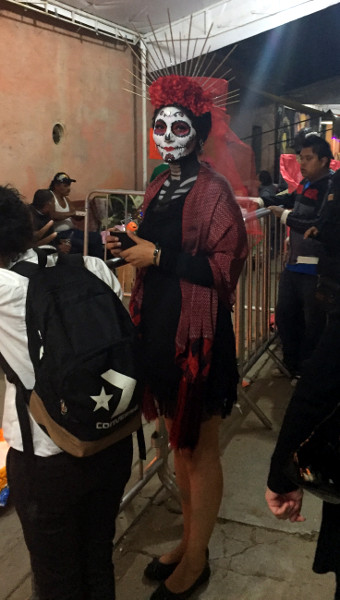
taken on in Xoxocotlán, Oaxaca, Mexico very early in the morning of November 1st, 2017. Preceding Día de Muertos the day is often called Día de los Inocentes or Día de los Angelitos, either of which seem fitting for a student cut off in the last days of her education.
I don't know the age of the woman in the photo but she's likely within the broad bandwidth of today's graduate school years. I'd spent a fair bit of that night in graveyards, a thing that's done in South Mexico during the first week of November. There's nothing in Canada to compare with the good fellowship these gatherings.
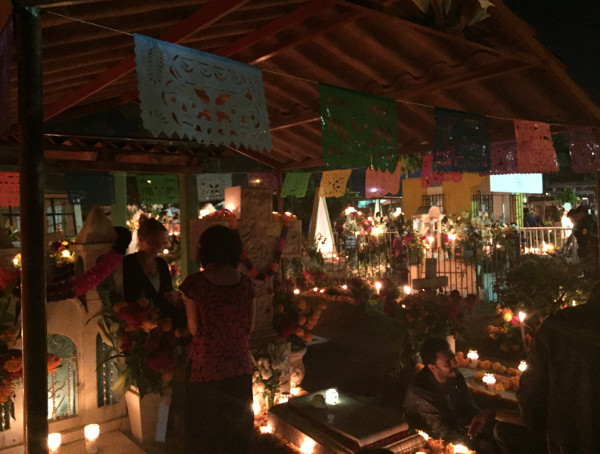
It's not spooky the way our Halloween is. There's something comforting to the idea that the dead, and more poignantly those taken in youth, return each year.
I thought I was invisible, but not only does the young woman see me, she's posed and even looks a bit smug at having caught someone so confident that he's caught her.
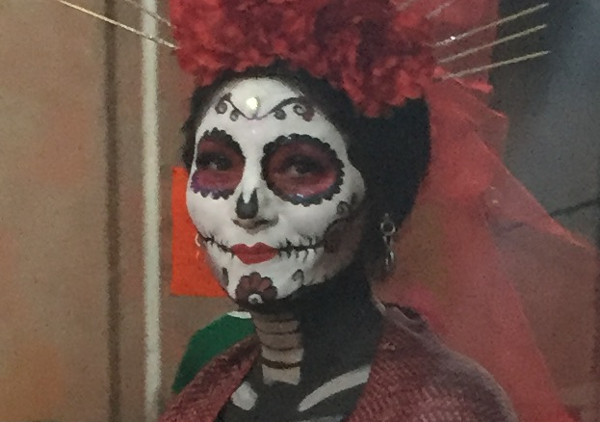
After having the picture up on my screen for some time I noticed my subject was also holding a camera,

and if she didn't bother to take a similar shot of me, she could have. For all I know she's typing a photo-essay right now and explaining how some Anglo with a vampire complexion is a startling metaphor for the day the dead arise. It's a nice equalizer I think. Walker Evans's farmers couldn't shoot back
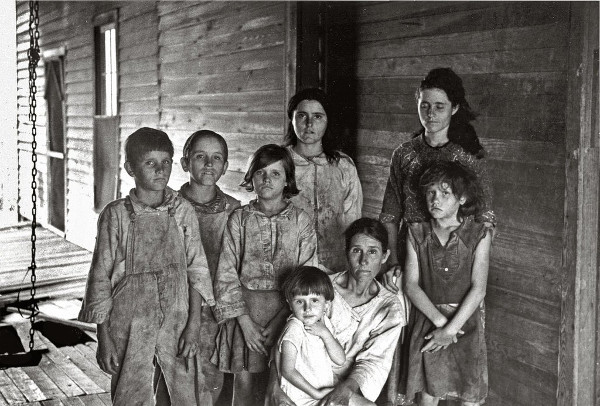
Walker Evans from "Let Us Now Praise Famous Men" 1936
but today we're all gunslingers, armed equally for a street shootout.
If you want to read my photo allegorically call it folly at trying to get the better of death.
If I'm not already the butt of a joke in a situation where the subject clearly has the upper hand, notice the carved pumpkin balanced on the edge of her left thumb, head tipped back and laughing uproariously, at me, the situation, all the living, and all the dead.
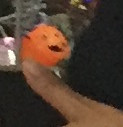
It's a Mexican laughter. Hysterical, gruesome, transcendent. A laughter that emanates from the country's great murals.
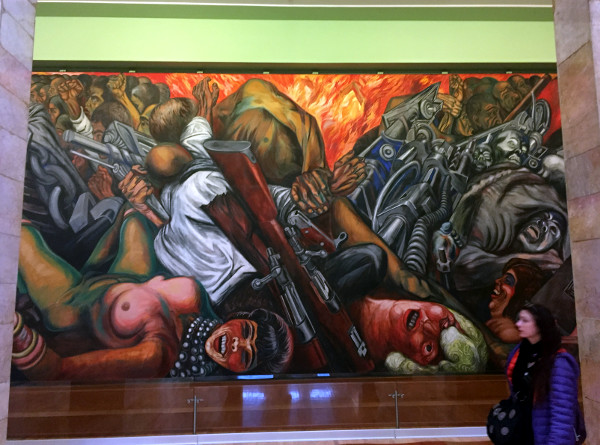
José Clemente Orozco, Catharsis, 1934 (with a person walking into my photo, sorry.)
The woman at the base of Orozco's picture impresses me as more indomitable than the soldiers, despite their weapons and vigorous communist salutes.
* * *
As a small child the only incident of a children's book that left me in a huddle of fear beneath stifling bedclothes, was John Tenniel's illustration of Alice after she's eaten the "eat me" cake and not so much grown as elongated. Alice in Wonderland was read to me when I was too young to read it myself, so to my four-year-old eyes the print might as well have been all the unsayable names of God.
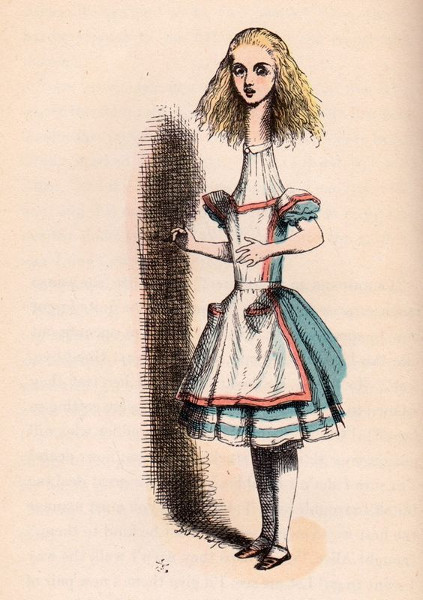
Fear is a contagion, and what is frightening about stretched Alice is the fear in her eyes. The terror that results from her change of scale and proportion is an assault on identity. She can't remember her name and thinks she might be one of her sisters, Ada or Mabel, and this is no comfort. For what is death to the western sensibility but the ultimate assault on identity? No wonder she cries tears so large she threatens to drown all of Wonderland.
If she bears no resemblance to the woman in Orozco's painting her stance and severity have a good deal in common with the Xoxocotlán woman. The position of the legs, left overlapping right, even the footwear is pretty close. Both necks are elongated, the Xoxocotlán woman's with the faux vertebrae of a skeleton costume. The difference is in the hands, and only because Alice was born too soon to have a mobile phone.
Tenniel exploits the lack of an electronic device and allows Alice's limbs to hover helplessly in space. Alice can neither connect with humanity's communication web nor shoot back at the artist who's documenting her horror. It's almost as though the woman in Xoxocotlán assumed her stance to remind me of childhood terrors.
* * *
Note Alice's hair, which is the very definition of wiry. The Xoxocotlán woman's hair IS wire, shooting skyward, as though charged by a Van de Graaff generator.
Perhaps that was the technology used to achieve this publicity shot for Harold Lloyd's High and Dizzy

a prime example of his high-altitude-slapstick-without-a-net. Thanks to the actor's union, studio legal departments, or just plain good sense, Hollywood films don't allow this stuff anymore.
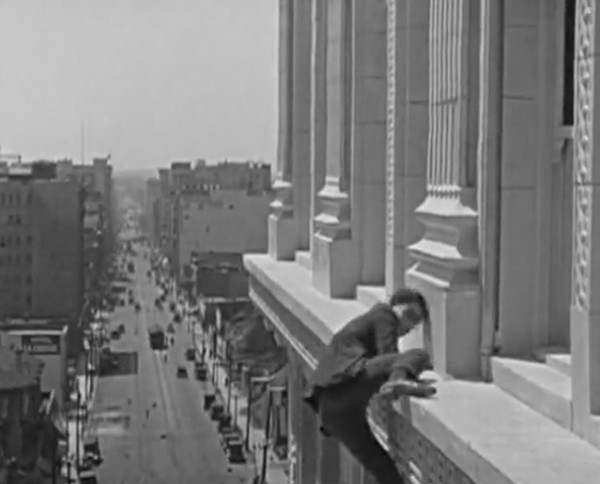
With the magic of YouTube though, we are seconds away from resuscitating a 20-something Harold Lloyd, alive as only a person on the ledge of annihilation can be.
As I watch an alternative scenario runs through my head. One in which those hands give out, a failing of a different order than the slapstick stumbles of ordinary vaudevillians. In my imagination I hear distant sirens followed by the appearance of futile ambulances they attach to, and finally the howls of loved ones arriving at the scene.
This alternative reality changes my 21st century only very slightly. The silent comedy chapter of my film textbook is now footnoted with a cautionary tale of star system hubris and testosterone fueled courage and its tragic victim.
The ledge sequence in High and Dizzy takes seconds in real time but stays hours in psychic time. In an age supposedly immune to filmed horrors, people I've shown it too routinely say, "I can't watch this."
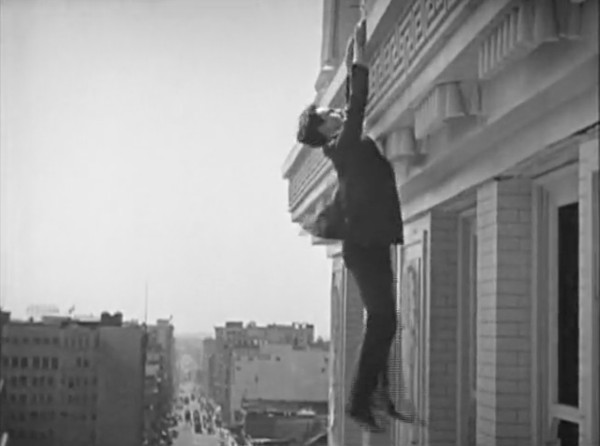
As a child I used to put myself in dangling situations a few feet off the ground. Defeatism infected me long before true physical exhaustion and I would quickly let myself fall. The painful landing seemed better than the anticipation that it might happen.
It was a lot like when I trembled under childhood bedclothes, thinking of that elongated Alice a few inches from my bed, pressed between pages, her page saturated in the vivid ink that brought her to life. So intense was her potential energy that at last I couldn't take it anymore. I thrust off my blankets, turned on the bedside light and grabbed the book.
For seconds I allowed the terror page to show through the one that proceeded it. Thinking: This ghost image is even worse! But it wasn't. When I turned the page and saw the image full-on it was even scarier than I'd imagined when there was still the soft owl-light of the hallway and parents there to restore order. Now, alone, the page starkly side-lit as in a film noir, it was so horrifying that I couldn't even scream.
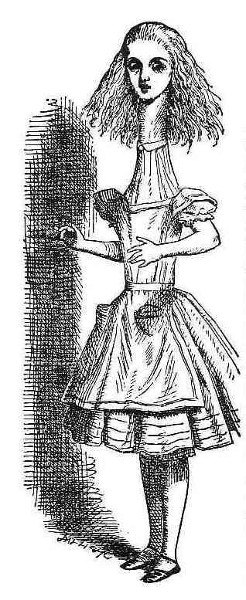
I'm fairly sure that if were to finger-walk Harold's ledge, I'd again succumb to that neurotic desire to get the worst over with. That would be bad. And it's why Harold Lloyd's high wire comedy (?!) epitomizes the saying "you can't look but you can't look away."
* * *
Certainly watching these movies has made me keep well back from railings protecting me from any kind of a fall, though others clearly don't suffer from this phobia,
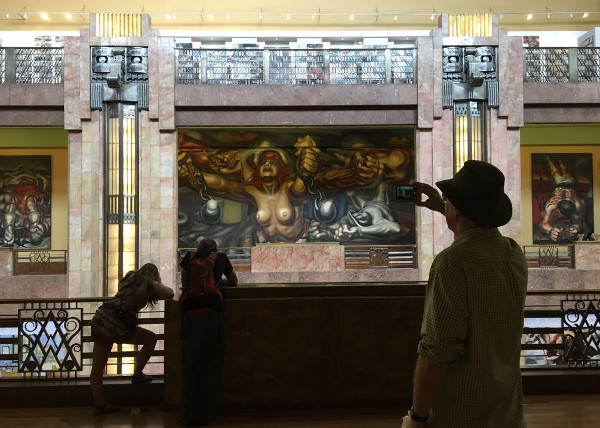
David Alfero Siqueiros, La Nueva Democracia, 1945 (with even more stuff in the way this time)
and yes that dork with the camera is me. I'd like to say a texted copy appeared on my phone from a mystery address as I turned to see the skeletal Xoxocotlán woman disappearing into the shadows of the Palacio de Bellas Artes in Mexico City. But unsurprisingly it was simply text-forwarded by my Mexican friend, justifiably exposing my outsider's gaze.
* * *
I'm typing these words on November 11th, yet another instance of the world making November the month for remembering the dead.
It's the day of the year on which I'm most acutely aware of my first name, a name no one calls me by other than physicians in walk-in clinics who get it from my OHIP card, and I never correct them because if the diagnosis is really dire I can then pretend it's about someone else.
I do, however, cringe when I hand my passport to Mexican border officials, since it's a first name I share with the current American President.
More importantly I share it with a great-uncle who died when he stepped on a mine in France early in 1945. Like most soldiers of his time I doubt he served out of ideological commitment, but rather like A.E. Housman, whose soldiers address us collectively from the grave
Here dead we lie
Because we did not choose
To live and shame the land
From which we sprung.
* * *
It makes me jittery to think of the number of people alive in comparison to the number of dead. I haven't done the math, but surely the ratio is extreme. Like the ratio of the Pequod's dead crew to living Ishmael, the sole survivor. (There are benefits to being an outsider.)
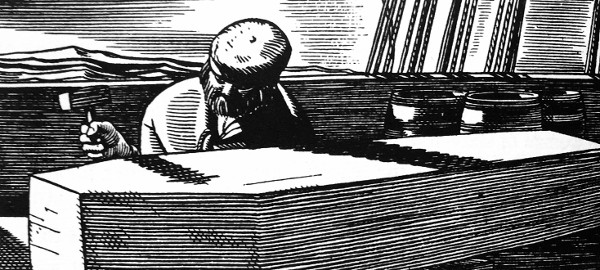
Rockwell Kent, 1930
It's one of the great moments in literary gallows humour. Queequeg has contracted a terrible fever and is determined to have a coffin built for his impending death and burial at sea. But he recovers. And he doesn't even get to occupy it days later when, with the rest of the Pequod's crew he perishes in the maelstrom. Helpfully the coffin serves as a liferaft for Ishmael.
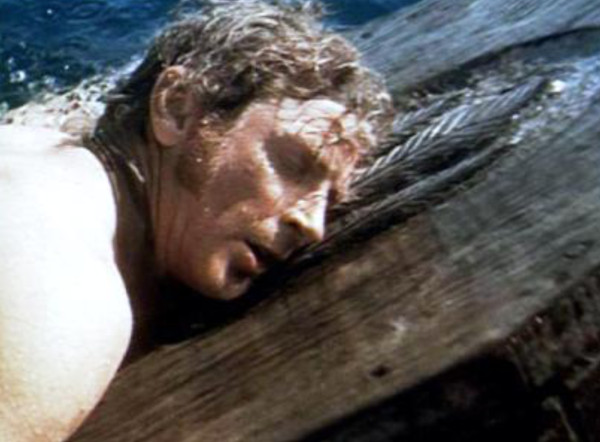
Moby Dick, 1956
Is it just me or does John Baseheart's Ishmael look like some surfer dude, after a bad ride through Pipeline?
* * *
One my duties as Hall Director was dealing with infractions to the residence code of conduct. Most were handled in a meeting with the student accompanied by a warning that only a certain number of such incidents were allowed before the student would be expelled from the residence system.
However, a few incidents had safety implications so serious the housing office immediately removed the student from the building. The following one qualified. I'll refer to the student simply as X, a) because I honestly can't remember his name, and b) because it harmonizes well with the cemetery of Xoxocotlán, Oaxaca, Mexico
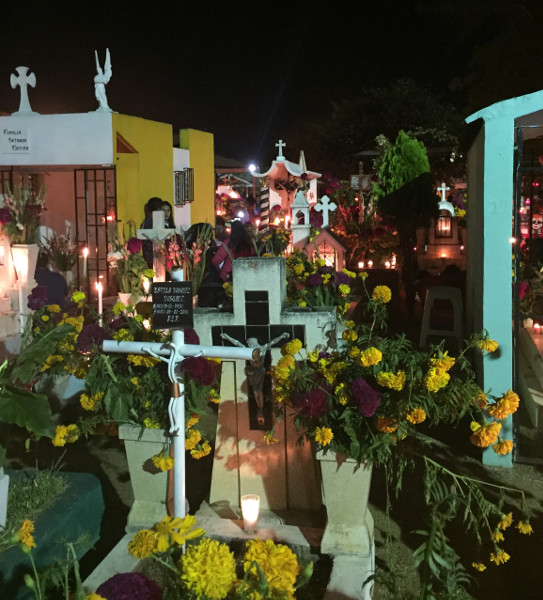
wherein, as mentioned, I spent the small hours of November 1st -with its crosses and the many 'x'es of its address. (Can I just say that I love the opportunity to hit the 'x' key repeatedly as I type. For English writers it's surely the most neglected of letter keys and I'm always impressed the 'x' on my computer is so free of self-esteem issues and, really, one of my lower maintenance keys.)
Bates has five floors. Count them if you want.
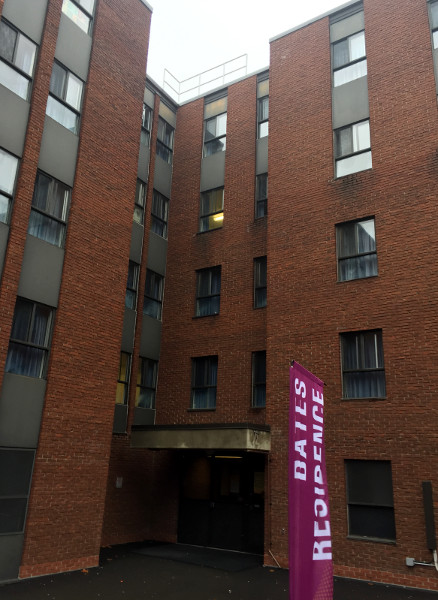
The fifth floor rooms, whose windows form the planes of an exterior 90-degree angle, have possibilities for the adventurous student.
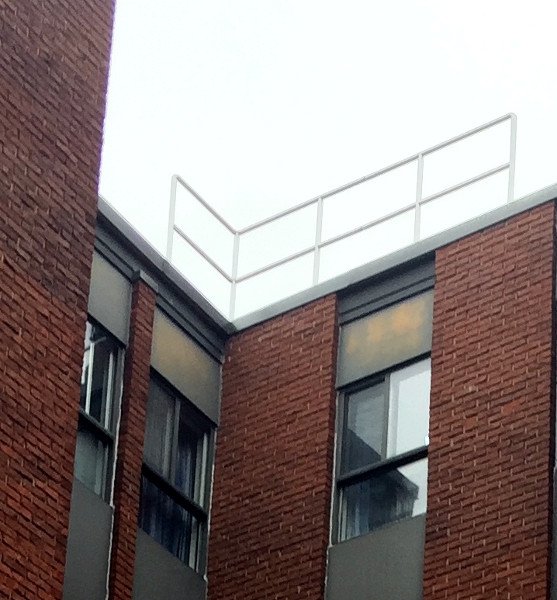
One night X, under the influence of alcohol, decided to go all Harold Lloyd (Harold Lloyd without window ledges I might add) and moved batlike along the high exterior walls.
I don't know the human origami X had to go through to do this, and I don't want to, but with both windows open he insinuated his body from interior to exterior in such a way that, with a foot resting on the bottom edge of the windows perpendicular to one another, his hands were able to grip the roof's scant cornice.
He then, by the strength of his upper arms, pulled his body onto the roof. (Your guess is as good as mine as to whether that railing has been added as a preëmptive strike against alcohol fueled undergraduate shenanigans: a horror if discovered mid-climb; an ante-upper if foreknown.)
Once on the roof X made his way easily to the facilities door, locked on the inside but unlocked on the outside, and by opening it he allowed friends onto the roof-friends likely in a similar state of inebriation.
What is most alarming about the activity is that it had become a tradition among fifth floor residents, at an age where peer pressure is high and risk assessment low, and thus the wall-crawl was a throwdown to a fresh coven of daredevils each year.
Knowing this it was impossible to shrug metaphorical shoulders and say 'what's done is done and thankfully no one was hurt.' So I went through the disciplinary process and had X expelled and I think anyone in my position would have done the same thing.
Incidentally I learned about the wall-crawl from a student who chose to suffer the wrath of other residents rather than remain silent and possibly have to live with consequences of subsequent ascents. A few days after I'd expelled X her room was vandalized.
It's unlikely that it was X, who was not only gone from the building but officially PNG and watched for by campus security. I never discovered who'd done it. Draw what conclusions you may about peer honour and the collateral damage done by the risk taker.
I quite liked X. He was much different when sober, did a lot to help out with the residence, and I imagine he grew to be a responsible citizen and now has to do things like preventing young men from killing themselves. As with the impulsive deployment of firearms, deaths and disabilities from the misuse of high-rises are measurable, prevented ones aren't.
* * *
In Mexico, November 2nd is an official holiday and other than essential services everyone has it off. I walked the streets of Oaxaca that morning and they're as deserted as Christmas morning in Canada. Allow for the fact that I'm an outsider and likely know less than these dogs
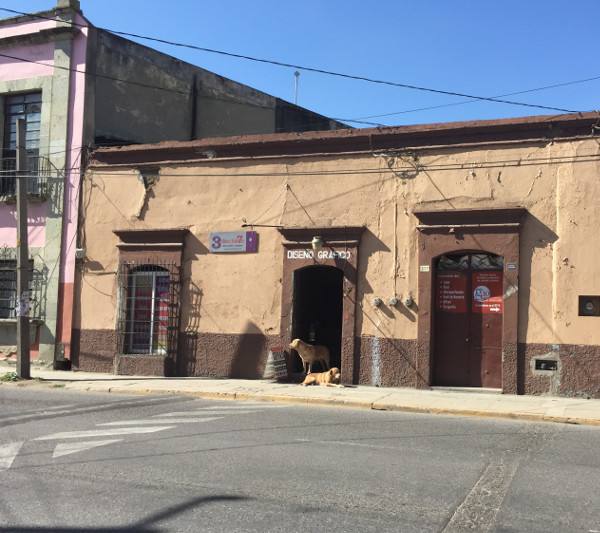
Morning, November 2 2017, Oaxaca Mexico.
about what the day means to people who live in South Mexico. But I do know that a persistent refusal to let go of the dead is a defining characteristic of our species. And universal.
That same morning I passed this sign which I found inexplicable.
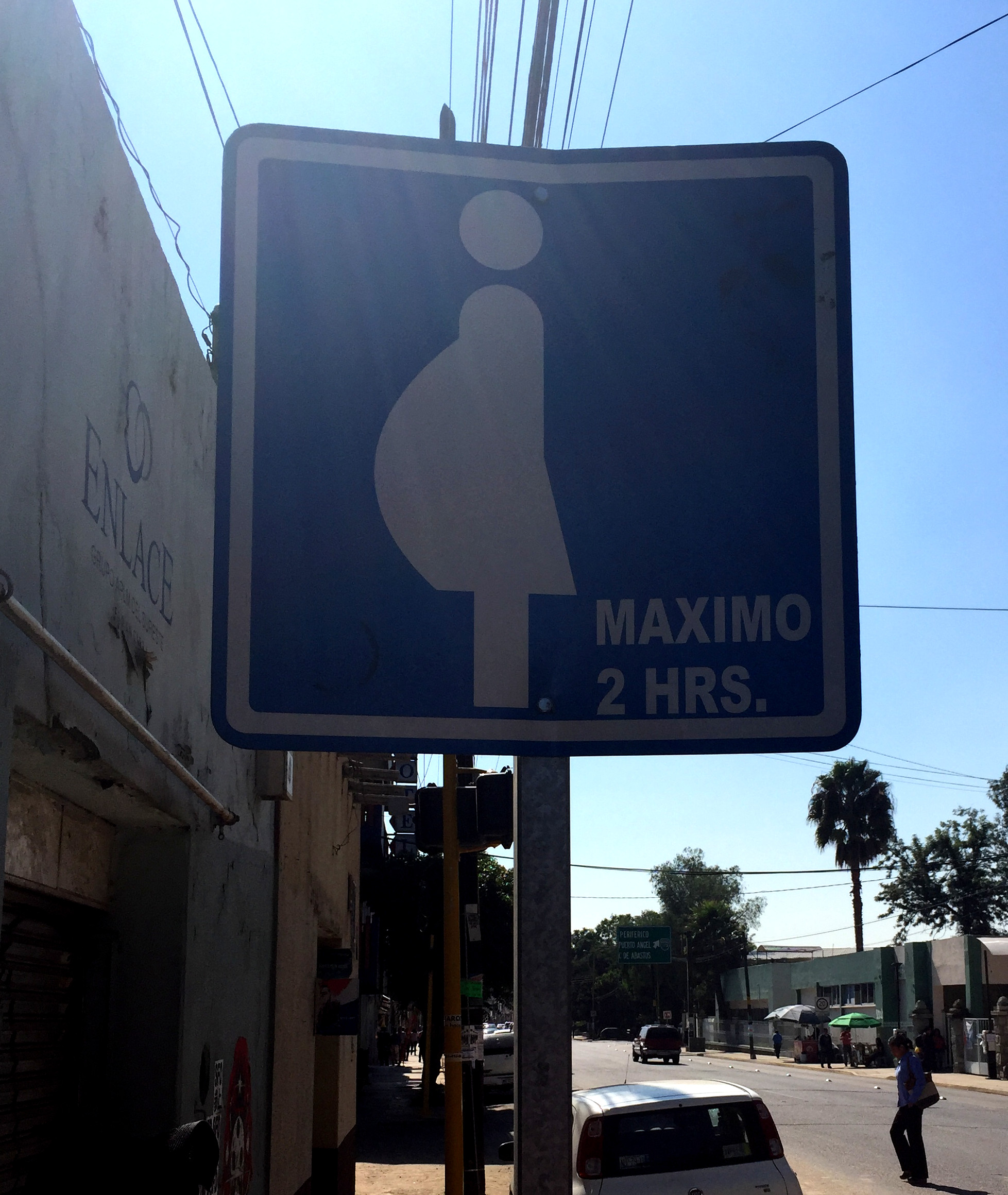
It seemed absurd to pass a law saying that women could only be pregnant for two hours. My Mexican friend explained that it allows pregnant women free parking for two hours.
As you know, I look closely at the ethical implications of parking ordinances. How on earth are these contingent facts documented? Is there some official wrist stamp from an obstetrician when you test positive for pregnancy? And are you then presented with an official health department hourglass that you invert and place on your dash whenever you leave your car?
My Mexican friend doesn't know, but I'll happily use this sign to say goodbye to the month of the returning dead and hello to the month of an unusual birth.
You must be logged in to comment.
There are no upcoming events right now.
Why not post one?